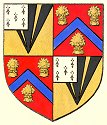 |
A SHORT HISTORY OF TETTENHALL10. The nineteenth century - the village and the people |
|
 |
A SHORT HISTORY OF TETTENHALL10. The nineteenth century - the village and the people |
|
|
The village was still mainly located around Lower Green beneath the church. In the first half of the nineteenth century it was still largely rural, with some 30 or 40 farms, mostly tenanted, which supplied the needs of the ever expanding Wolverhampton, from which Tettenhall was still separated by a mile and a half of fields. The main landowners were still the Wrottesleys, who had always been locally influential, but who now took once again to the national stage. Sir John Wrottesley became an MP for Staffordshire and a leading reformist Whig. (Later his son became an eminent scientist, a government adviser on all matters scientific, the President of the Royal Society and a leading astronomer).
There were some other, lesser gentry with substantial residences in the area: the Wightwicks had moved to Dunstall Hall, the Pearsons were at "The Mansion of Tettenhall" (later “Tettenhall Towers"), the Fryers were at the Wergs and the Fowlers at Pendeford Hall.
In 1790 the members of the Tettenhall Association for the prosecution of
criminals included many prominent landowners, including Thomas Fowler,
Peter Hinckes, Thomas Pearson, John Fleeming and Henry Granger.
Meanwhile the ordinary residents laboured in the fields or walked into
Wolverhampton to work, attended church and the occasional local
celebration of national events, attended cock fights and bear baiting,
beat the parish bounds, and compiled the short and simple annals of the
poor. The population continued to grow throughout the nineteenth century. In 1826 the porch, south aisle and gallery of the church were rebuilt to accommodate more people.
In 1866 a new church, Christ Church, was built at Tettenhall Wood where, since the enclosure, a small population had become established. In 1868 Tettenhall Wood was created a separate parish.
On the other side of the Smestow, at Oak Hill, Finchfield, a daughter chapel to St. Michael's was built to serve the small settlement that had grown up there. In 1883 St Michael’s again had its south aisle rebuilt. |